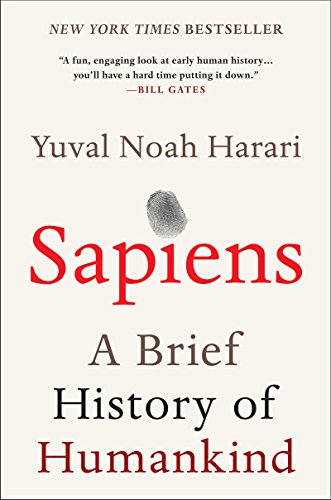

This article is an excerpt from the Shortform summary of "Sapiens: A Brief History of Humankind" by Yuval Noah Harari. Shortform has the world's best summaries of books you should be reading.
Like this article? Sign up for a free trial here .
What was the Cognitive Revolution in Sapiens? How did it allow our species to survive, while other human species, such as Neanderthals, disappeared?
The Cognitive Revolution was the moment in human history when our ancestors developed three new abilities: flexible language, communication about 3rd parties, and collective fictions. The Cognitive Revolution allowed homo sapiens to develop the societies that characterize the species today.
We’ll cover the three aspects of the Cognitive Revolution as described in Yuval Noah Harari’s book Sapiens and expand upon the above Cognitive Revolution definition.
The Cognitive Revolution
The first major revolution for Sapiens was the Cognitive Revolution. Before that point, Sapiens weren’t particularly special among animals. Over time, they had evolved the abilities to cross oceans and invent things like bows and arrows, sewing needles, oil lamps, and art. They had become humans that we’d recognize today, with our level of intelligence and creativity. But until the Cognitive Revolution of 70,000 years ago, they weren’t superior to other humans.
Although the use of fire hastened Sapiens’ ascent, it was the Cognitive Revolution that ultimately distinguished Sapiens from other humans.
What caused the Cognitive Revolution? No one’s really sure, but it was probably a chance gene mutation that changed the way the brain was wired.
The Cognitive Revolution involved the development of three new abilities, all related to language, that helped Homo sapiens outpace their fellow humans.
Cognitive Revolution Ability #1: Flexible Language
Their language gave Sapiens a huge advantage over their fellow animals, including their fellow humans. This was the first aspect of the Cognitive Revolution in Harari’s Sapiens.
Language itself isn’t particularly special—apes and monkeys communicate vocally, as do elephants, whales, and parrots. One reason the language of Sapiens was different was that it was more complex. Rather than communicating simple ideas the way green monkeys do (“Careful! A lion!” or “Careful! An eagle!”), the language of Sapiens could warn someone about a lion, describe its location, and plan how to deal with it. This allowed them to plan and follow through on complex actions like avoiding predators and working together to trap prey.
Cognitive Revolution Ability #2: Gossip
A second distinction of the Sapiens language during the Cognitive Revolution was its ability to convey gossip. We think of gossip as a bad thing, but using language to convey information about other people is a way to build trust. Trust is critical for social cooperation, and cooperation gives you an advantage in the struggle to survive and pass on your genes.
Even today, most of our communication is gossip, if we define gossip as talking about other people. If we hear from a friend that the banker down the street offers fair interest rates on mortgage loans, we feel comfortable doing business with that banker, even though he’s a stranger. On the flip side, if we hear that the banker is a fraud, we stay away from her. Gossip helps us avoid strangers who may cheat us or be undependable.
Neanderthals probably didn’t have the capability to gossip. Their language was equipped to talk about lions and bison, but not other people. When they couldn’t talk about others, they couldn’t assess the trustworthiness and dependability of strangers. That meant they could only cooperate with the people they knew intimately, family members and close locals.
Because an animal can only know so many other animals intimately, the lack of the ability to gossip kept Neanderthal groups small. Sapiens, on the other hand, could form groups of up to 150 people. They didn’t need to know every group member personally to trust them. In a battle, a small group of Neanderthals was no match for a group of 150 Sapiens.
Cognitive Revolution Ability #3: Fictions
A third benefit of the Sapiens’ language during the Cognitive Revolution (in Harari’s Sapiens) was how it was used to create fictions, also known as “social constructs” or “imagined realities.”
Being able to communicate information about things that don’t exist doesn’t seem like an advantage. But Sapiens seem to be the only animals who have this ability to discuss things that don’t have a physical presence in the world, like money, human rights, corporations, and God.
For instance, you can’t convince a monkey to give you its banana on the argument that if it does, it will get unlimited bananas when it dies and goes to heaven. Your negotiations with monkeys are limited because you can only promise rewards that exist materially in this world. Monkeys can’t create imagined realities like heaven.
Collective Fictions
Collective fictions were an important piece of the Cognitive Revolution. In and of itself, imagining things that don’t exist isn’t an asset—you won’t aid your chances of survival if you go into the forest looking for ghosts rather than berries and deer.
What’s important about the ability to create fictions is the ability to create collective fictions, fictions everyone believes. These collective myths allow people who’ve never met and otherwise would have nothing in common to cooperate under shared assumptions and goals.
Collective fictions aren’t the same as lies. These aren’t lies because everyone collectively believes them. For example, members of the UN weren’t lying when they insisted that Libya’s government respect the rights of its citizens, even though Libya, human rights, and the UN itself are all imaginary realities, or social constructs. The borders that separate Libya from other countries are man-made, not physical features of the landscape; human rights is a concept many of us believe in, but rights don’t exist outside our collective imagination; and, like Libya, the UN is a social construct, an organization that has no physical existence.
While humans lived without these social constructs for millennia, today, imaginary realities in some cases matter more than objective realities. For instance, the survival of actual entities like rain forests and endangered river dolphins depends on the charity of imaginary entities like the United States and non-profit organizations.
The Cognitive Revolution: Chimp and Sapiens Social Groups
We can see the advantages of flexible language, gossip, and shared fictions by comparing chimp social groups with Sapiens social groups.
Chimp Social Groups
When chimps become alpha males, leaders of their troops, it’s usually due to the fact that they’ve created strong social ties with the members of the group. But in order for this social structure to work, everyone in the troop has to know the others well. Chimps who haven’t met won’t trust each other and won’t know who is of higher rank.
The fact that everyone has to know one another limits the troops to between 20 and 50 chimps. Otherwise, the group destabilizes and the troop breaks up into smaller troops, which generally don’t cooperate with each other.
Sapiens Social Groups after the Cognitive Revolution
Until the Cognitive Revolution, Sapiens functioned in social groups similar to those of chimps. But the ability to gossip meant that members didn’t have to know all the other members intimately—they could know them through word of mouth.
This means that Sapiens social groups can be much bigger than chimp social groups. But you can still only effectively gossip about a maximum of 150 people—beyond this number, it’s just too hard to keep track of all the people. Even today, businesses with fewer than 150 people don’t necessarily need concrete rules and a clear hierarchy to function. Because everyone knows each other well, social bonds keep the order. Beyond 150 people, the group becomes chaotic as there’s no way to be intimately connected with, or gossip about, so many people.
So gossip was a good first step toward creating large, cohesive groups (and, consequently, dominating other animals, including humans). But Sapiens have managed to found cities, nations, and empires of hundreds of millions of subjects. How did they cross the 150 threshold?
This is where common myths, or collective fictions, come into play. Cities, nations, and empires aren’t real entities. They exist only in the collective mind of the group.
For example, churches can hold sway over millions of people all over the world because of the belief system that binds their followers to each other, even when they’re strangers and have nothing else in common.
Likewise, citizens of a nation are often tied together by common ideals established by the nation’s founders and the shared stories they tell the world about themselves.
If we could only talk about things that really existed, like rivers, mountains, and lions, we’d never be able to form the powerful social and cooperative networks created by “imaginary” entities like churches and nations. The world would be chaotic.
Although imagined, these myths are crucial. Without collective fictions, the systems built on them collapse. And as we’ll see, most of our modern systems are built on these imagined realities. These myths are powerful, and the fact that they’re not rooted in objective reality doesn’t undermine them.
Collective fictions allowed early Sapiens to cooperate within extremely large groups of people they’d never met, and it rapidly changed their social behavior.
The Cognitive Revolution: Genetic Evolution Versus Social Evolution
Usually, it takes a genetic mutation to significantly change behavior, and that takes hundreds, if not hundreds of thousands, of years.
For example, common chimpanzees live in hierarchical groups led by the alpha male, whereas their relatives the bonobos live in egalitarian groups led by females. Chimps can’t suddenly decide that they too want to live in an egalitarian society. Their social behavior is ingrained in their genes. Such a change would have to come from their DNA.
Until the Cognitive Revolution (as depicted in Harari’s Sapiens), the social and technological evolution of Sapiens also depended on changes in DNA. But the Cognitive Revolution—and the language, collective fictions, and cooperation it brought with it—allowed Sapiens to evolve much faster than other humans. We can now change our social structures, interpersonal behavior, and economic behavior within decades, rather than over hundreds of years.
Cognitive Revolution Example: The Power of the Pope
We can see how the advent of “fictions” made social evolution independent of biological evolution in the example of the Pope.
In the societies of our chimp relatives, the alpha male uses his position of power to mate with as many females as possible, ensuring that he passes his genes to the next generation. In the animal world, this is the primary, instinctive goal—to survive long enough to pass on your DNA and keep your ancestral line alive. The sole purpose of gaining power is to help you survive and procreate.
However, in modern human societies, power is divorced from procreation and institutions are passed along not through genes but through fictions.
For example, Catholic priests, Buddhist monks, and Chinese eunuchs all hold sway over their societies. They’re also meant to be celibate. Their celibacy isn’t the result of limited resources or a lack of females. It’s also not the product of a genetic mutation.
There’s no genetic basis or survival need for the Catholic Church, but it hasn’t died out. It’s passed from one generation to the next via stories rather than genes.
The Cognitive Revolution set up the world that we recognize today.
———End of Preview———

Like what you just read? Read the rest of the world's best summary of "Sapiens" at Shortform . Learn the book's critical concepts in 20 minutes or less .
Here's what you'll find in our full Sapiens summary :
- How Sapiens outlived and outlasted the 8+ other human-like species on Earth
- The 3 critical revolutions in human existence that led to our domination of the planet
- How much of what powers our world today is really just a shared mass delusion
- What the future of humanity might look like







RE “Cognitive Revolution (Sapiens)”
Unfortunately the SELECTIVE narrative Harari choses to describe and categorize “cognitive revolution” omits the key human elements (ie self-delusion, grandiosity, manipulation, deception, lunacy — all of which shine thru here in this excerpt for any lucid reader) that has led humans to be largely destructive and therefore not being wise at all …
At the core of homo sapiens is unwisdom (ie, madness) and so the human label of “wise” (ie, sapiens) is a complete collective delusion — study the free scholarly essay “The 2 Married Pink Elephants In The Historical Room”
Once you understand that humans are “invisibly” insane you’ll UNDERSTAND (well, perhaps) why they, especially their alleged experts such as megalomaniacal Harari, perpetually come up with myths and lies about everything … including about themselves (their nature, their intelligence, their origins, etc).
“All experts serve the state and the media and only in that way do they achieve their status. Every expert follows his master, for all former possibilities for independence have been gradually reduced to nil by present society’s mode of organization. The most useful expert, of course, is the one who can lie. With their different motives, those who need experts are falsifiers and fools. Whenever individuals lose the capacity to see things for themselves, the expert is there to offer an absolute reassurance.” —Guy Debord
So the misleading misdirecting notion of “Cognitive Revolution Example: The Power of the Pope” is, if translated into actual reality, this: “Cognitive Revolution Example: The Power of Psychopaths”
James states a criticism but offers no counter analysis. He does not describe exactly which point he disagrees with and why. Not sure, but my guess is that we have a Jesus freak on our hands stating that we have only God’s wisdom and that man has been the same since creation without evolution. What say u James?
James,
Your argument fails to persuade me. It was, however, irritably entertaining. Keep up the good work!
Will